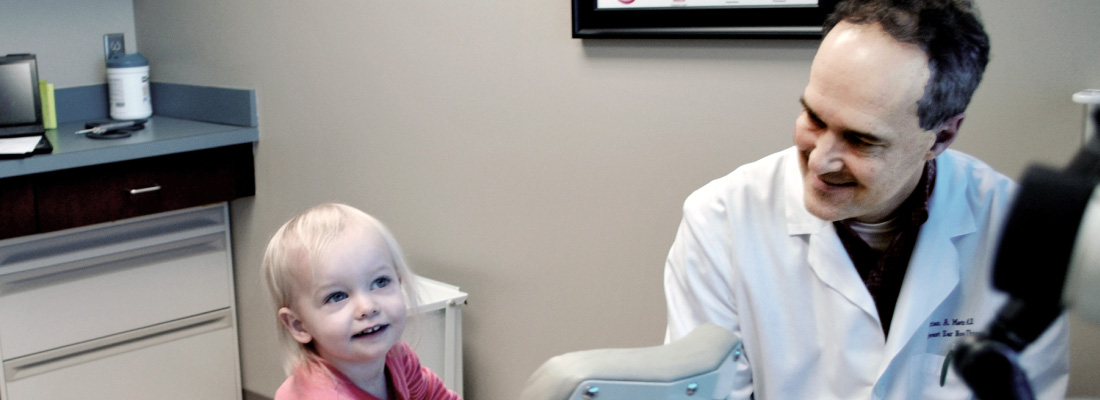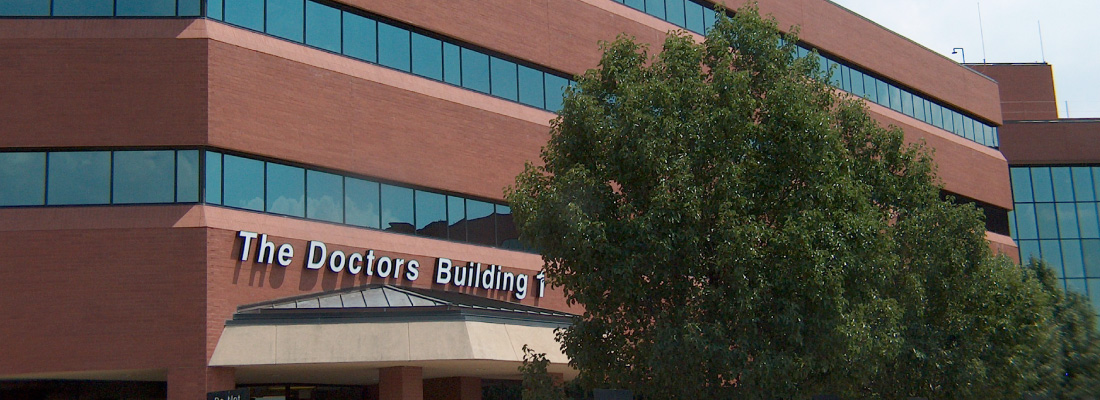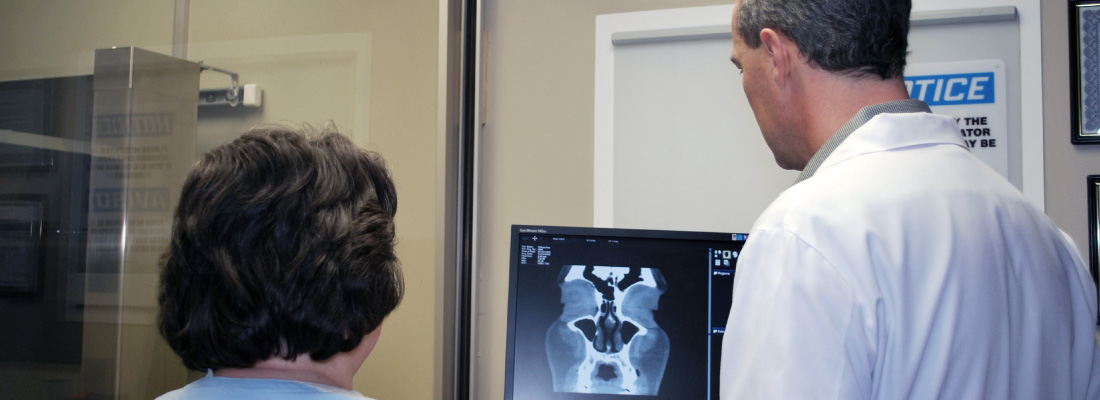Nosebleeds
Nosebleeds (called epistaxis) are caused when tiny blood vessels in the nose break. Nosebleeds are very common and affect many people at some point in their lives. In the United States, about 60 percent of people will experience a nosebleed in their lifetime. They can happen at any age, but are most common in children around the ages of two to 10, and adults around the ages of 50 to 80.
What Are the Symptoms of a Nosebleed?
There are two categories of nosebleeds. Anterior nosebleeds occur when the bleeding is coming from the front of the nose and posterior nosebleeds occur when the bleeding originates from further back in the nose, often where the source of bleeding cannot be seen without examination. Common symptoms can include:
- Anterior nosebleeds begin with a flow of blood out one or both nostrils
- Posterior nosebleeds can begin further back in the nose and may flow down the throat
What Causes a Nosebleed?
Most nosebleeds are in the front part of the nose and start on the nasal septum, the wall that separates the two sides of the nose. The septum contains blood vessels that can be easily damaged. Irritation from blowing the nose or scraping with the edge of a sharp fingernail is enough to tear the vessels and cause a nose bleed. Anterior nosebleeds are also common in dry climates, or during winter months when dry, heated indoor air dehydrates the nasal membranes and makes the blood vessels more likely to rupture.
Causes of recurring or frequent nosebleeds may include:
- Allergies, infections, or dryness that cause itching and lead to picking the nose
- Vigorous nose blowing that ruptures superficial blood vessels
- Problems with bleeding caused by genetic or inherited clotting disorders (e.g., hemophilia or vonWillebrand’s disease)
- Medications that prevent blood clotting (e.g., anticoagulants like coumadin/warfarin, XARELTO®, or anti-inflammatory drugs like ibuprofen or aspirin)
- Fractures of the nose or the base of the skull (a nosebleed occurring after a head injury should raise suspicion of serious concern)
- Hereditary hemorrhagic telangiectasia, a disorder involving birthmark-like blood vessel growths inside the nose
- Tumors, both malignant (cancerous) and nonmalignant (benign), must be considered, particularly in older patients or smokers
What Are the Treatment Options?
It is important to try to determine if the nosebleed is anterior or posterior. Posterior nosebleeds are often more severe and almost always require a physician’s care.
Anterior Nosebleeds—When dry air is believed to be the cause of the nosebleed, it may result in crusting, cracking, and bleeding. This can be prevented by placing a light coating of saline gel, petroleum jelly, or an antibiotic ointment on the end of a Q-tip and gently applying it inside the nose, especially on the middle portion of the nose (the septum).
Follow these steps to stop an anterior nosebleed:
- Stay calm, or help a young child stay calm. A person who is agitated may bleed more profusely than someone who feels reassured and supported.
- Sit up and keep the head higher than the level of the heart.
- Lean forward slightly so the blood doesn’t drain into the back of the throat.
- Gently blow any clotted blood out of the nose. Spray the nose with a nasal decongestant; oxymetazoline is the active ingredient in most over-the-counter sprays.
- Using the thumb and index finger, pinch all the soft parts of the nose.
- Hold the position for five minutes. If it’s still bleeding, hold it again for an additional 10 minutes.
Should the bleeding continue after this, you should seek medical care. Treatment administered by a medical professional at this point may include cautery (a technique in which the blood vessel is burned with an electric current, silver nitrate, or a laser to stop the blood flow) or nasal packing.
Posterior Nosebleeds—More rarely, a nosebleed can begin high and deep within the nose and flow down the back of the mouth and throat, whether the patient is sitting or standing. Posterior nose bleeds differ from anterior nose bleeds because direct pressure on the outside of the nose will not stop the bleeding, and spraying the nose with a decongestant is less likely to work. It is important to seek prompt medical care if the bleeding does not stop to prevent heavy blood loss.
Posterior nosebleeds are more likely to occur in older people and people with previous nasal or sinus surgery or injury to the nose or face. Generally, treatment includes cautery and/or packing the nose. The nose may be packed with a special gauze, sponge, or an inflatable balloon to put pressure on the blood vessel; most of these need to be removed in two to three days. Sometimes the packing is an absorbable material and does not need to be removed. You should ask your provider what type of packing they used and if it will need to be removed by a professional.
Frequent Nosebleeds—If frequent nosebleeds are a problem, it is important to consult an ENT (ear, nose, and throat) specialist, or otolaryngologist, who will carefully examine the nose using an endoscope (a pencil-sized scope) to see inside the nose before making a treatment recommendation.
What Are Some Tips for Preventing a Nosebleed?
Some tips you can follow to help prevent future nosebleeds include:
- Keep the lining of your nose moist by gently applying a light coating of saline gel, petroleum jelly, or an antibiotic ointment with a cotton swab three times daily, including at bedtime. Common products include Ayr® Saline Nasal Gel, Bacitracin, A and D Ointment, Eucerin®, Polysporin®, and Vaseline®.
- Keep children’s fingernails short to discourage nose picking.
- Counteract the effects of dry air by using a humidifier.
- Use a saline nasal spray to moisten dry nasal membranes.
- Quit smoking. Smoking dries out the nose and irritates it.
- Do not pick or blow your nose after the initial bleeding has stopped.
- Do not strain or bend down to lift anything heavy after initial bleeding has stopped.
- Keep your head higher than your heart after initial bleeding has stopped.
- Call your doctor if bleeding persists after 30 minutes, or if a nosebleed occurs after an injury to your head.
Neck Mass in Adults
A neck mass is an abnormal lump in the neck. Neck lumps or masses can be any size—large enough to see and feel, or they can be very small. A neck mass may be a sign of an infection, or it may indicate a serious medical condition. It does not necessarily mean you have cancer, but it does mean you may need additional evaluation to receive an accurate diagnosis.
What Are the Symptoms of a Neck Mass?
Common symptoms in patients with a neck mass at higher risk for cancer (see “What Causes a Neck Mass” below) include:
- The mass lasts longer than two to three weeks
- The mass gets larger
- The mass gets smaller but does not completely go away
- Voice change
- Trouble or pain with swallowing
- Trouble hearing or ear pain on the same side as the neck mass
- Neck or throat pain
- Unexplained weight loss
- Nasal blockage in one side of the nose
- Breathing difficulty
- Bleeding from nose and oral cavity
- Coughing up blood
- Skin lesion on the face or scalp that is growing or changing color
What Causes a Neck Mass?
Neck masses are common in adults and can occur for many reasons. You may develop a neck mass due to a viral or bacterial infection. Ear or sinus infection, dental infection, strep throat, mumps, or a goiter may cause a neck mass. If your neck mass is from an infection, it should go away completely when the infection goes away.
Your neck mass could also be caused by a noncancerous (benign) tumor or a cancerous (malignant) tumor. Cancerous neck masses in adults are most often due to head and neck squamous cell carcinoma (HNSCC). Other causes for a neck mass may be due to cancers such as lymphoma, thyroid or salivary gland cancer, skin cancer, or cancer that has spread from somewhere else in the body.
Long-term tobacco use (cigarettes, cigars, chewing tobacco, or snuff) and alcohol use are the two most common causes of cancers of the mouth, throat, voice box, and tongue. Another common risk factor for cancers of the neck, throat, and mouth is a human papilloma virus (HPV) infection. HPV infection is usually transmitted sexually. HPV found in the mouth and throat is called “oral HPV.” Some high-risk types of oral HPV infection can cause head and neck cancers.
HNSCC of the tonsil and base of the tongue has gone up because of the increase in HPV infections. HPV-related cancers often lack the common risk factors of tobacco and alcohol use, and tend to affect younger adults. Patients with HPV-positive HNSCC may have some of the symptoms listed here, but many times a neck mass will be the only sign of this type of cancer.
When Should I See a Doctor?
See your doctor and/or an ENT (ear, nose, and throat) specialist, or otolaryngologist, if the lump in your neck lasts longer than two to three weeks. This is a persistent neck mass, which means that the lump has not gone away. You should also see a doctor if you are not sure how long you have had the neck mass because your neck mass may mean that you have a serious medical problem. If you have any of the head and neck symptoms listed above, in addition to the neck mass, you should see your doctor right away. It may not be cancer, but you need to be evaluated. Your doctor will discuss any tests needed for diagnosing your neck mass and your follow-up care.
What Are the Diagnostic and Treatment Options?
Your doctor will ask about your medical history, and examine your head and neck. They may perform (or recommend) an endoscopy, which is a procedure that inserts a small tube with an attached camera through your nose to look inside your throat, voice box, and the opening of your esophagus. If a more detailed examination is required, the endoscopy will be performed in an operating room under anesthesia.
In addition, your doctor may order tests to help diagnose your neck mass, such as a CT, MRI, or PET (positron emission tomography) scan (if needed) to get a more detailed picture of the neck mass than normal X-rays can provide.
A biopsy involves taking a sample of tissue from the neck mass to make a diagnosis. There are different types of biopsies based on your medical history and the location of your mass, including:
- Fine Needle Aspiration Biopsy (FNA)—An FNA is the best initial test to diagnose a neck mass. A small needle is put into the mass and tissue is pulled out. An FNA is often done in your doctor’s office. It is well-tolerated by most patients. It can be done with or without ultrasound-guided needle biopsy.
- Core Biopsy—A core biopsy is another way to diagnose a neck mass, typically performed if an FNA did not confirm a diagnosis. A core biopsy uses a slightly larger needle and gets a larger piece of tissue. It is well tolerated and has a low risk of complications.
- Open Biopsy—An open biopsy should typically be done only after FNA and/or core biopsy have failed to make the diagnosis. It is the next step to diagnose a neck mass. It is a more invasive procedure. Open biopsy is done by a surgeon in the operating room and you will need anesthesia. An open biopsy may remove only portion of the mass or the whole mass. Because open biopsies are more invasive, there is a somewhat higher risk for complications.
Your doctor will explain next steps and discuss a follow-up plan once a diagnosis has been made. If the neck mass is found to be cancerous, treatment options include surgery, radiation therapy with or without chemotherapy, or a combination of these treatments depending on the diagnosis and stage of the disease. Some neck masses may be thought to be benign (not cancerous) at first, but are later found to be cancer, which is why a follow-up plan is so important. You and your doctor need to discuss the method for follow-up that works best for you. You should call for your results if you have not heard from the doctor or do not have a follow up appointment.
What Questions Will My Doctor Ask Me?
Your ENT specialist will ask you some basic health questions, as well as questions about your medical history such as:
- When did you first notice the lump? Has it grown?
- Have you had a recent illness?
- Do you have any trouble with eating, talking, swallowing, breathing or hearing?
- Any sore spots in your mouth or throat?
- Do you have any sore or growing spots on your scalp, neck or face?
- Have you lost weight?
- Are citrus fruits or tomatoes painful to eat?
- Do you have ear pain or sore throats that don’t go away?
- Has your voice been hoarse?
- Have you coughed up any blood?
- Do you currently smoke, or do you have a smoking history? How much? How long?
- Do you drink alcohol? How much? How long?
- Do you chew tobacco?
- Do you have a history of head and neck cancer?
- Any radiation exposure to your head or neck?
- Do you have any family history of head and neck cancer?
What Questions Should I Ask My Doctor?
- What causes masses in the neck?
- Is the mass in the neck cancerous?
- How urgently should I be evaluated?
- Is the mass in the neck hereditary?
- What investigations are needed to diagnose the neck mass?
- What are the treatment options for neck mass?
- When will I hear back from you with the results of the biopsy?
Nasal Fractures
A broken nose, or nasal fracture, can significantly alter your appearance. It can also make it much harder to breathe through your nose. Getting struck on the nose, whether by another person, a door, or the floor is not pleasant. Your nose will hurt, usually a lot. You’ll likely have a nose bleed and soon find it difficult to breathe through your nose. Swelling develops both inside and outside the nose, and you may get dark bruises around your eyes (black eyes).
Nasal fractures can affect both bone and cartilage. A collection of blood (called a septal hematoma) can sometimes form on the nasal septum, a wall made of bone and cartilage inside the nose that separates the sides of the nose.
What Are the Symptoms of a Nasal Fracture?
Symptoms of a nasal fracture can include:
- Pain
- Displaced bone and/or cartilage (nasal septum)
- Changes in the appearance (shape) of the nose
- Nose bleed
- Difficulty breathing through the nose
- Collection of blood (septal hematoma)
- Swelling and bruising of nose and eyelids
What Causes a Nasal Fracture?
Nasal fractures, or broken noses, may result from facial injuries in contact sports or falls. Injuries affecting the teeth and mouth may also affect the nose. To help prevent a broken nose, wear protective gear to shield your face when participating in contact sports.
If you’ve been struck in the nose, it’s important to see a physician to check for septal hematoma. Seeing your primary care or an emergency room physician is usually the best way to determine if you have a septal hematoma or other associated problems from your accident. If a septal hematoma is present, it must be treated promptly to prevent worse problems from developing in the nose.
If you suspect your nose may be broken, you should see an ENT (ears, nose, and throat) specialist, or otolaryngologist, within one week of the injury. If you are seen within one to two weeks (one week for children), it may be possible to repair your nose immediately. If you wait longer than two weeks, you will likely need to wait several months before your nose can be surgically straightened and fixed. An untreated broken nose can leave you with an undesirable appearance, as well as permanent breathing difficulty.
What Are the Treatment Options?
Your doctor will ask you several questions and examine your nose and face. You will be asked to explain how the fracture occurred, the state of your general health, and how your nose looked before the injury (bring a picture to your appointment, if possible). Your doctor will examine not only your nose, but also the surrounding areas including your eyes, jaw, and teeth, and will look for bruising, cuts, and swelling.
Sometimes your physician will recommend an X-ray or computed tomography (CT) scan. These can help identify other facial fractures, but are not always helpful in determining if you have a broken nose. The best way to determine that your nose is broken is if it looks very different or is harder to breathe through.
If your nose is broken but not out of position, you may need no treatment other than rest and being careful not to bump your nose.
If your nose is broken so badly that it needs to be repositioned, you have several options. Your nose can be repaired in the office in some situations. However, many situations require general anesthesia, particularly if the septum has also been damaged. Your doctor can give you local anesthesia, reposition the broken bones into place, and then hold them in the right location with a plastic, plaster, or metal cast. This cast will then stay in place for one week. In the first two weeks after the injury, your doctor may offer you this kind of repair, or a similar approach using general anesthesia in the operating room.
If more than two weeks have passed since the time of your injury, you may need to wait a while before having your nose straightened surgically. It may be necessary to wait two to three months before a good repair can be done, by which time there will be less swelling, and your nose will begin to heal as best it can. Reduced swelling will allow the surgeon to get a more accurate picture of how your nose originally looked. This type of surgery is considered reconstructive plastic surgery, as its goal is to restore your appearance to the way it was prior to injury.
If your repair is done within two weeks of the injury, restoring prior appearance and breathing is the only possible goal. If you have waited several months for the repair, it is often possible to change the appearance of your nose as you desire through combined nasal fracture repair and rhinoplasty procedures.
What Questions Should I Ask My Doctor?
- Should I be on antibiotics or other medications after a nasal fracture?
- What physical activities can I do while healing?
- Can there be secondary treatments after my initial corrective surgery if needed?
- If there were cuts or lacerations associated with my nasal fracture, when can scar revision procedures be addressed?
Ménière’s Disease
Ménière’s disease (also called idiopathic endolymphatic hydrops) is one of the most common causes of dizziness originating in the inner ear. In most cases only one ear (unilateral) is involved, but both ears (bilateral) may be affected.
Ménière’s disease typically affects people between the ages of 40- and 60-years-old and can impact anyone. Occasional symptoms include vertigo (attacks of a spinning sensation), hearing loss, tinnitus (a roaring, buzzing, or ringing sound in the ear), and a sensation of fullness in the affected ear. These episodes typically last from 20 minutes up to eight to 12 hours.
Hearing loss is often intermittent, occurring mainly at the time of the attacks of vertigo. Loud sounds may seem distorted and cause discomfort. Usually, the hearing loss involves mainly the lower frequencies, but over time this often affects higher tones as well. While hearing loss initially fluctuates, it often becomes more permanent as the disease progresses.
What Are the Symptoms of Ménière's Disease?
Ménière’s disease symptoms may include:
- Dizziness or vertigo (attacks of a spinning sensation)
- Hearing loss
- Tinnitus (a roaring, buzzing, or ringing sound in the ear)
- Sensation of fullness in the affected ear
- Symptoms tend to come and go together
What Causes Ménière's Disease?
Although the cause is unknown, Ménière’s disease symptoms are due to increased volume of fluid in the inner ear. Too much fluid may accumulate either due to excess production or inadequate absorption. In some individuals, especially those with involvement of both ears, allergies or autoimmune disorders may play a role in producing Ménière’s disease. In some cases, other conditions may cause symptoms similar to those of Ménière’s disease.
People with Ménière’s disease have a “sick” inner ear and are more sensitive to factors such as fatigue and stress that may influence the frequency of attacks.
To find out how to help and what is causing this condition, your physician will take a history of the frequency, duration, severity, and character of your attacks, the duration of hearing loss, or whether it has been changing, and whether you have had tinnitus or fullness in either or both ears. When the history has been completed, diagnostic tests to assess your hearing and balance may be performed. They may include:
Hearing tests—An audiometric examination (hearing test) typically shows a sensory type of hearing loss in the affected ear. Speech discrimination (the patient’s ability to tell one word from another) is tested as well.
Balance tests—An electronystagmogram (ENG) test may be performed to measure balance by following eye movement when warm and cool water, or air, are inserted into the ear. Often this shows that the balance function is reduced in the affected ear. Rotational or balance platform testing may also be used to evaluate balance.
Other tests—Electrocochleography (ECoG) looks for inner ear fluid pressure in some cases of Ménière’s disease. Other hearing and imaging may help to rule out other causes as well.
What Are the Treatment Options?
Although there is no cure for Ménière’s disease, the attacks of vertigo can be controlled in nearly all cases. Treatment options include:
- A low salt diet and a diuretic (water pill)
- Anti-vertigo medications (used to stop acute attacks)
- Intratympanic injection with either dexamethasone or gentamicin
- Surgery
Your ENT (ear, nose, and throat) specialist, or otolaryngologist, will help you choose the treatment that is best for you, as each has advantages and drawbacks. In many people, careful control of salt in the diet and the use of medication to help release extra fluid can control symptoms well.
Treatments aim to save the inner ear parts that work and clear out parts that are permanently injured.
Intratympanic injections inject medication through the eardrum into the middle ear space where the ear bones reside. This treatment is done in your ENT specialist’s office one or more times. One type of medication, Gentamicin, eases dizziness but may increase hearing loss and worsen overall balance. Corticosteroids do not cause hearing loss but are less helpful for dizzy spells.
Surgery
Surgery is needed in only a small minority of patients with Ménière’s disease. If vertigo attacks are not controlled by conservative measures and are disabling, a surgical procedure might be recommended.
Labryrinthectomy and eighth nerve section are procedures in which the balance and hearing mechanism in the inner ear are destroyed on one side. This is considered when the patient with Ménière’s disease has poor hearing in the affected ear. Labryrinthectomy and eighth nerve section result in the highest rates for control of vertigo attacks.
What Should I Do If I Have an Attack of Ménière's Disease?
Lie flat and still, and focus on an unmoving object. You might even fall asleep while lying down and feel better when you wake up.
Take vestibular suppressants including meclizine, which calm the inner ear.
To help prevent an attack, avoid stress and excess salt ingestion, caffeine, smoking, and alcohol. Get regular sleep and eat properly. Remain physically active, but avoid excessive fatigue. Consult your ENT specialist about other treatment options.
What Questions Should I Ask My Doctor?
- Can my hearing loss be treated?
- What are other closely related diagnoses?












